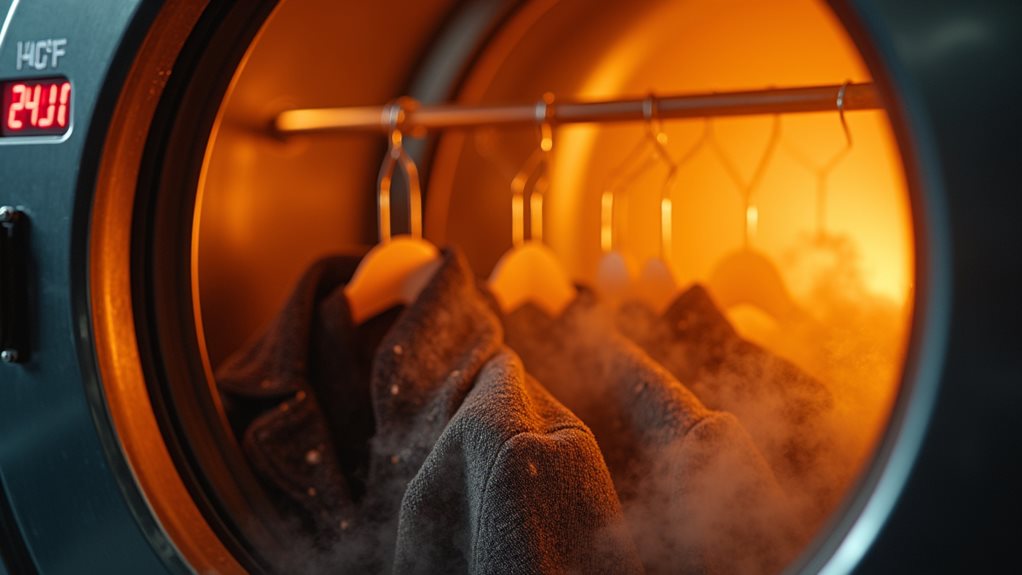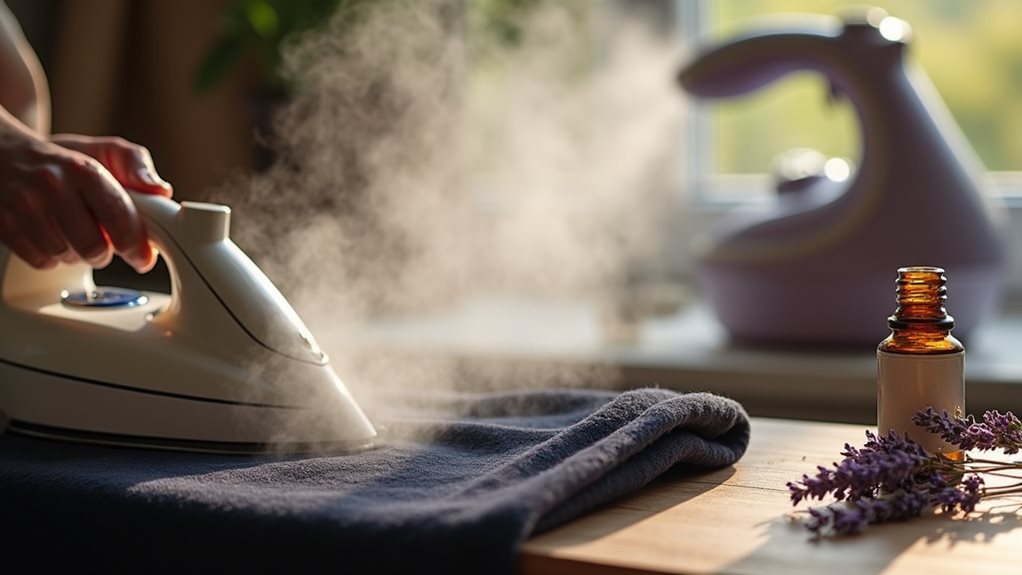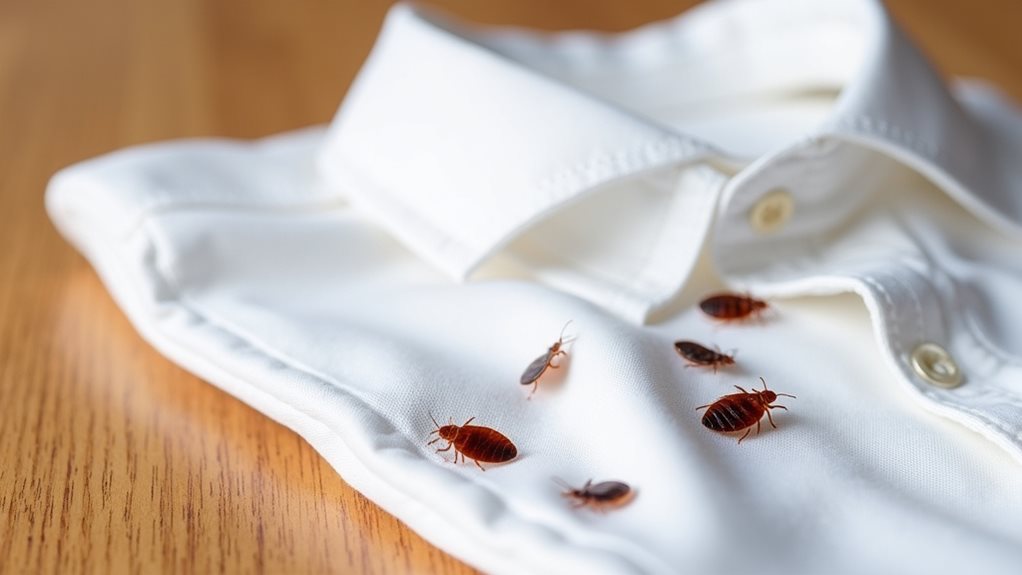Bed bugs can survive dry cleaning, though many won’t make it through the process. While the chemical solvents like PERC will eliminate visible bugs and some eggs, those sneaky little critters hiding deep in seams and fabric folds often escape unharmed since most dry cleaning doesn’t reach the sustained 120°F needed to kill all life stages. You’ll need temperatures above 140°F for complete elimination, which standard dry cleaning rarely achieves, leaving you with survivors ready to restart their unwelcome colony unless you understand the full strategy.
Understanding How Dry Cleaning Works Against Bed Bugs
When my neighbor Sarah discovered tiny bloodstains on her designer blouses last summer, she rushed everything to the dry cleaner, convinced that the chemical process would obliterate her bed bug nightmare once and for all.
Here’s the reality: dry cleaning uses perchloroethylene (PERC), a chemical solvent that can kill bed bugs, but it’s not the foolproof effective method Sarah hoped for.
While this cleaning process eliminates many adult bugs and visible eggs, it has considerable limitations of dry cleaning that you need to understand.
Dry cleaning kills many bed bugs and eggs, but significant limitations prevent it from being a complete solution.
Unlike high temperatures that guarantee extermination, this chemical solvent instead relies on penetration, which often fails in fabric seams and crevices where bugs hide.
If you’re dealing with infested clothing and a bed bug infestation, dry cleaning helps but won’t completely solve your problem.
The high heat exposure generated in commercial dry cleaning machines typically reaches temperatures sufficient to destroy bed bugs on fabric items that cannot be washed in hot water.
Temperature Requirements for Killing Bed Bugs and Their Eggs

The harsh truth about temperature requirements became crystal clear to me after my own battle with these persistent pests, when I learned that bed bugs aren’t just tough—they’re practically thermal warriors that demand specific heat levels to surrender.
You’ll need sustained temperatures of 113°F to kill bed bugs themselves, but their stubborn eggs require even higher heat at 120°F for effective elimination.
Here’s where dry cleaning disappoints: most chemical solvents used in this cleaning process can’t reach these lethal thresholds, making pest control through professional cleaning services unreliable.
While extreme cold below freezing for several days works too, high heat remains your best weapon—which is why home dryers at 140°F prove more effective than fancy dry cleaning for infested clothing items! 🔥
However, professional dry cleaning that reaches temperatures of 140°F or higher can actually be lethal to bed bugs in all life stages, making it an effective treatment option for delicate fabrics that cannot withstand hot water washing.
Why Some Bed Bugs May Survive the Dry Cleaning Process

Disappointment hit me like a cold wave when I discovered that my expensive dry cleaning bill didn’t guarantee the complete elimination I’d desperately hoped for.
Frankly, learning why some bed bugs survive this process felt like uncovering a frustrating conspiracy against homeowners everywhere.
Here’s the brutal truth: bed bug eggs are ridiculously resilient, often withstanding the chemical solvents that should theoretically kill them.
Your dry cleaning temperature mightn’t reach the sustained heat levels needed for effective eradication, since these pests require consistent temperatures above 113°F.
Those sneaky bugs hide deep in clothing seams and fabric folds, making complete pest control nearly impossible through dry cleaning alone.
Even when infested items get cleaned, reintroduction to contaminated environments means you’re back to square one 😤.
The effectiveness ultimately depends on factors like the duration of heat exposure and the specific dry cleaning method used, which is why professional pest control services remain necessary for comprehensive bed bug eradication.
Best Practices When Taking Infested Items to Dry Cleaners

Although my first instinct was to secretly drop off my bed bug-infested clothes without mentioning the problem (embarrassment runs deep, trust me), I’ve learned that transparency with your dry cleaners isn’t just courteous—it’s absolutely essential for effective treatment.
When you inform them about bed bug infested items, they’ll use perchloroethylene (PERC), which actually works better than regular cleaning to eliminate bed bugs at every life stage.
Pack your infested laundry in sealed plastic bags separately from clean clothes—cross-contamination is sneaky like that. Don’t place anything on communal surfaces either, because spreading the problem to other customers would haunt my conscience forever.
While chemical solvents like PERC are effective against bed bugs, the success of treatment depends on factors such as fabric type and the extent of infestation.
Alternative Methods to Combine With Dry Cleaning for Complete Elimination

While dry cleaning works wonders on bed bugs, I’ve learned the hard way that relying on it alone is like bringing a knife to a gunfight—you need backup strategies that create an impenetrable fortress against these persistent little vampires.
Here’s my tried-and-true approach for complete elimination of bed bug-infested items:
- High temperature washing first – If your fabrics can handle it, wash at temperatures above 113°F before dry cleaning to kill bed bugs and their eggs immediately.
- Steam cleaning partnership – Follow up your dry cleaning with steam treatments that penetrate deep into fibers, reaching hiding spots that chemicals might miss.
- Professional heat treatments – Combine your pest control efforts with expert services that use extensive heat strategies targeting all life stages.
Remember that dry cleaning is most effective for clothing and delicate fabrics, but professional pest control services remain essential for treating mattresses, furniture, and other household areas where bed bugs commonly hide.
This multi-pronged approach transforms your battle plan into an unbeatable fortress!




